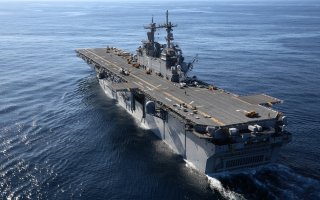The Marines Want Surplus Ships to Become Floating Gas Stations
It's time to fuel up against Beijing.
Here's What You Need to Know: The Marines want to make the most of their surplus ships.
The U.S. Marine Corps’s new strategy for fighting Chinese forces in the Western Pacific could orphan many of the U.S. Navy amphibious assault ships that Marines ride into battle.
Now two Navy lieutenant commanders have an idea what the fleet could do with the redundant vessels. Turn them into floating gas stations.
Ben Herring and Scott Richards both serve aboard the big-deck assault ship USS Wasp. Writing in Proceedings, the professional journal of the U.S. Naval Institute, Herring and Richards urged the Navy to use displaced amphibs as forward arming and refueling ships, or FARS.
“The basic tenet of the FARS concept is that ships within an amphibious task force are able to expand their roles beyond traditional amphibious missions to act as ‘lily pads’ for Marine Corps fixed- and rotary-wing assets and Navy rotary-wing aircraft,” the officers wrote.
“Amphibious ships acting in a FARS role can expand the range and distribution of anti-surface warfare, anti-submarine warfare, strike warfare, airborne early warning, scouting and logistics operations.”
FARS could fit into the major operating concepts the Marines and Navy are working on. The Marines are shifting away from counterinsurgency and traditional beach-assaults in favor of so-called “expeditionary advanced base operations,” or EABO. The Navy meanwhile is refining its concept for “distributed” operations.
The Corps’s concept involves Marine forces setting up heavily armed but temporary bases on remote islands in order to lob anti-ship missiles at Chinese vessels and support patrols by F-35 stealth fighters. The Navy’s concept envisions ships operating farther from each other and farther from enemy territory, all in order to make them harder to find and sink.
FARS could be the connective tissue between the two concepts. With Navy aircraft carrier battle groups and amphibious ready groups standing off potentially hundreds of miles away from Marine expeditionary bases, rotorcraft and planes could benefit from a refueling platform bobbing somewhere in the ocean mid-way between the naval groups and the island bases.
Turning an amphibious ship into a refueling platform probably wouldn’t involve a lot of changes to the vessel’s hardware. After all, amphibs already land, refuel and launch aircraft. But the Navy and Marines haven’t yet developed doctrine for FARS. In other words, no one really knows how a refueling platform fits in the fleet’s existing deployment processes.
“A major shift in doctrine will have to occur,” Herring and Richards wrote.
A major concern is how to protect and support the refueling ship without creating such a large concentration of forces that the FARS just becomes another big, slow target. “A ship that fills the forward arming and refueling role is a high-value unit, and the FARS concept potentially places it at risk,” Herring and Richards conceded. “There would be fewer assets available for layered defense while logistics support would be stretched.”
Still, the idea is worth considering as the Navy and Marine Corps begin reorganizing. No one doubts that, in the coming years, the Navy will need fewer amphibs than it once thought it might require for traditional beach-assault missions.
Those surplus ships might still play an important role in wartime.
David Axe served as Defense Editor of the National Interest. He is the author of the graphic novels War Fix, War Is Boring and Machete Squad.
This article first appeared in September 2019.
Image: U.S. Navy photo by Mass Communication Specialist Seaman Hunter S. Harwell

